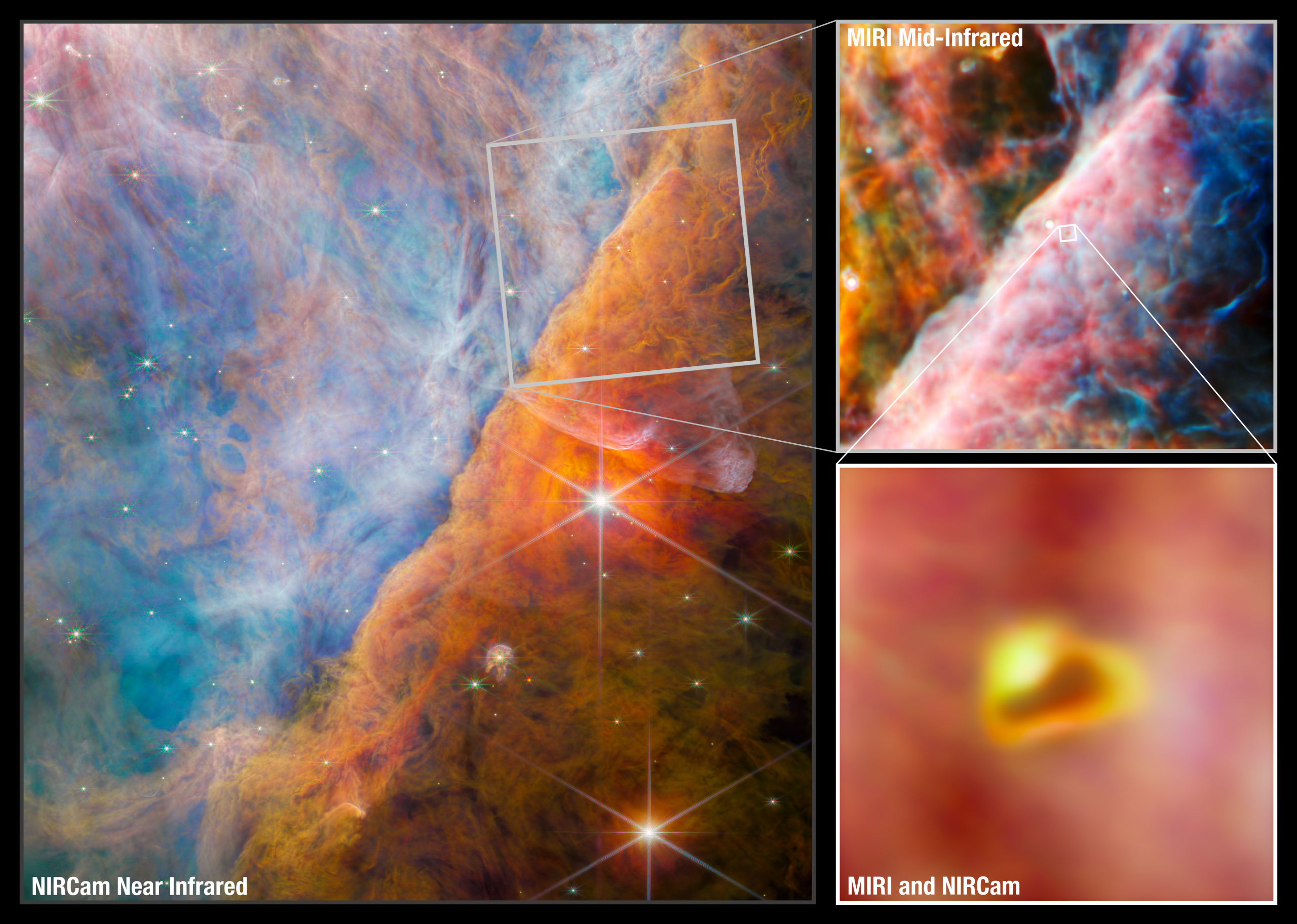In new data collected by the joint NASA/European Space Agency/Canadian Space Agency James Webb Space Telescope, an international team of scientists has — for the first time — found a carbon molecule inside a star’s protoplanetary disk located in the Orion Nebula. The molecule, called a methyl cation (CH3+), is a bit unusual. The molecule does not react with hydrogen all that efficiently but can react with other common molecules. This reaction allows for the creation and growth of more complex carbon-based molecules — like life.
The potential importance of CH3+ in universal carbon chemistry has been predicted by scientists since the 1970s. However, until Webb officially began operations in 2022, telescopes before and since have not detected the molecule in the universe. The incredibly sensitive array of Webb’s infrared instruments allowed the team, led by Olivier Berné of the French National Center for Scientific Research in Toulouse, to detect the molecule.
Located about 1,350 light-years away in the Orion Nebula, protoplanetary disk d203-506 is the focus of Webb’s observations and research by Berné et al. Webb observed the nebula using its near-infrared camera (NIRCam) and mid-infrared instrument (MIRI). Although only a spec in a vast area of swirling gas, dust, rock, and other cosmic materials, the team identified and analyzed Webb’s d203-506 data to discover CH3+ in the disk.

Annotated graphic of the Orion Nebula Webb image showing d203-506. (Credit: ESA/Webb/NASA/CSA/M. Zamani (ESA/Webb)/PDRs4All ERS Team)
Carbon compounds have long been known as the basis for all life forms on Earth. Without carbon, life and many other important processes in the environment would not be possible. Because of their importance to life and the formation of life, scientists are constantly searching the universe for different signs and forms of carbon – a field known as interstellar organic chemistry. Scientists looking for carbon in the universe usually look for carbon-containing molecular ions, because they can react with many other elements and molecules to form more complex structures.
CH3+ is one of these molecular carbon ions capable of reacting with other elements/molecules and forming complex structures. For decades, scientists have searched for the molecule throughout the universe because of its importance in building complex structures and life forms. CH3+ has long been referred to as the “foundation of interstellar organic chemistry.”
However, how do you see carbon molecules in a protoplanetary disk several thousand light-years away?
When trying to observe molecules in protoplanetary disks, scientists typically use radio telescopes and try to detect a molecule’s “perfect dipole moment” — a molecular property that means a molecule’s electric charge is permanently unbalanced because of its geometry (this gives the molecule a positive and negative “end”). Because CH3+ is perfectly balanced, it does not have a perfect dipole moment and, thus, cannot be detected with traditional radio telescopes. Instead, scientists are trying to detect the spectroscopic lines emitted by CH3+ in the infrared. Because Earth’s atmosphere would interfere with infrared observations, a space-based infrared telescope would be needed.

MIRI image of the location of d203-506 (center) within the Orion Nebula. (Credit: ESA/Webb/NASA/CSA/M. Zamani (ESA/Webb)/PDRs4All ERS Team)
When Webb — the world’s newest space-based infrared telescope — officially begins scientific operations in mid-2022, using the revolutionary telescope to detect CH3+ will be at the top of many scientists’ to-do lists. Webb’s immense sensitivity in the near-infrared and mid-infrared regions of the electromagnetic spectrum allows it to detect molecules and structures that are normally hidden from the view of instruments in visible and X-ray telescopes. . Furthermore, Webb’s incredible size and massive mirror allow it to see more of the universe than any other telescope before it. These properties make the Webb the ideal tool to detect CH3+.
While scientists expected Webb to eventually detect CH3+, many were surprised that the telescope and Berné et al. saw it as soon as they did (Webb was still in the middle of his first year of scientific observations). In fact, it took Berné et al. it took four weeks to interpret the CH3+ signal, which they didn’t know how to detect when they first saw it.
“This discovery of CH3+ not only confirms the incredible sensitivity of James Webb but also confirms the postulated central importance of CH3+ in interstellar chemistry,” said spectroscopic and co-author Marie-Aline Martin of Paris-Saclay University in France.
Because of its age and location in the Orion Nebula, d203-506, located around a small red dwarf star, is constantly bombarded with strong ultraviolet radiation from surrounding young stars. Many scientists currently believe that most star systems experience this period of intense exposure to ultraviolet radiation.
Used by scientists @NASAWeb has found an important carbon compound in space for the first time. Known as the methyl cation (pronounced cat-eye-on), it’s thought to help build more complex carbon molecules—the foundation for all known life: https://t.co/QVLCDQjCi8 pic.twitter.com/q9Hy0ZgXbt
— NASA (@NASA) June 26, 2023
However, interestingly, previous data suggest that ultraviolet radiation can kill compounds necessary for the formation of complex structures. However, CH3+ — a molecule capable of forming complex structures — was detected in a protoplanetary disk that was constantly exposed to ultraviolet radiation. What’s going on here?
In their study, Berné et al. explain that CH3+ may need ultraviolet radiation to exist. If this is true, ultraviolet radiation would serve as the energy source for CH3+ in the protoplanetary disk. If a disk experiences a period of intense exposure to ultraviolet radiation, the radiation appears to significantly alter the chemistry within the disk. To confirm this, Webb observed a disk that had not been exposed to intense ultraviolet radiation, where he found a lot of water. However, in d203-506 (which was exposed to radiation), Berné et al. did not see any water on the disk or surrounding areas.
“This clearly shows that ultraviolet radiation can completely change the chemistry of a protoplanetary disc. It may actually play a critical role in the early chemical stages of the origins of life by helping to produce of CH3+ — something that was probably underestimated before,” explained Berné.
The results of Berné et al. was published in the journal Nature on June 26.
“Our discovery was only possible because astronomers, modelers, and laboratory spectroscopists joined forces to understand the unique features observed by James Webb,” said Martin.
(Lead image: Webb image of the Orion Nebula. Credit: ESA/Webb/NASA/CSA/M. Zamani (ESA/Webb)/PDRs4All ERS Team)
#Webb #scientists #detection #carbon #molecule #protoplanetary #disk #NASASpaceFlight.com














Add Comment